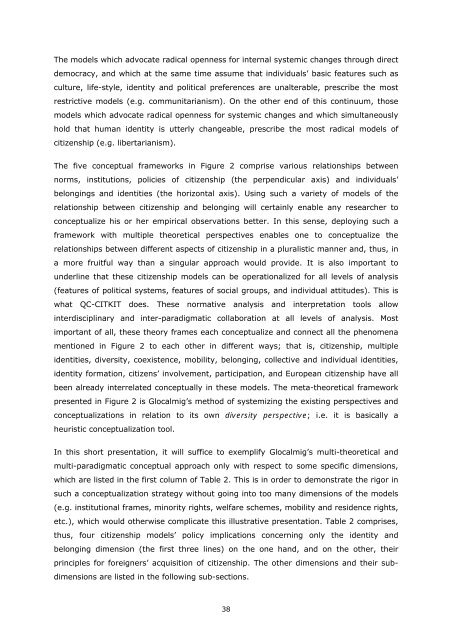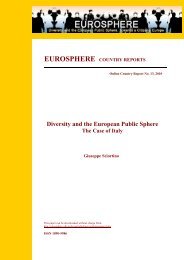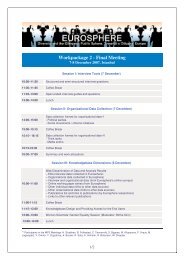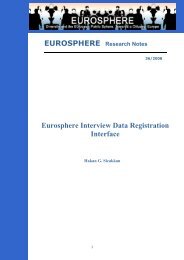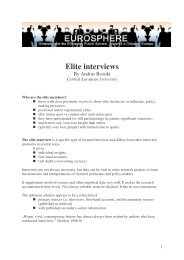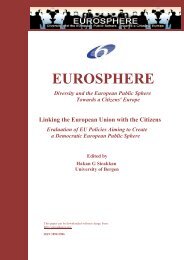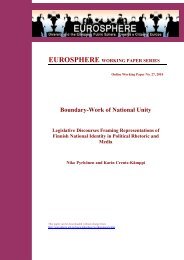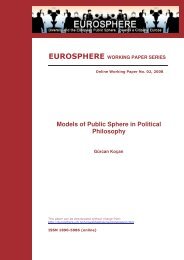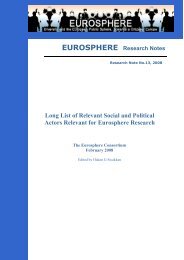Migrants, Minorities, Belongings and Citizenship. Glocalization and ...
Migrants, Minorities, Belongings and Citizenship. Glocalization and ...
Migrants, Minorities, Belongings and Citizenship. Glocalization and ...
Create successful ePaper yourself
Turn your PDF publications into a flip-book with our unique Google optimized e-Paper software.
The models which advocate radical openness for internal systemic changes through direct<br />
democracy, <strong>and</strong> which at the same time assume that individuals’ basic features such as<br />
culture, life-style, identity <strong>and</strong> political preferences are unalterable, prescribe the most<br />
restrictive models (e.g. communitarianism). On the other end of this continuum, those<br />
models which advocate radical openness for systemic changes <strong>and</strong> which simultaneously<br />
hold that human identity is utterly changeable, prescribe the most radical models of<br />
citizenship (e.g. libertarianism).<br />
The five conceptual frameworks in Figure 2 comprise various relationships between<br />
norms, institutions, policies of citizenship (the perpendicular axis) <strong>and</strong> individuals’<br />
belongings <strong>and</strong> identities (the horizontal axis). Using such a variety of models of the<br />
relationship between citizenship <strong>and</strong> belonging will certainly enable any researcher to<br />
conceptualize his or her empirical observations better. In this sense, deploying such a<br />
framework with multiple theoretical perspectives enables one to conceptualize the<br />
relationships between different aspects of citizenship in a pluralistic manner <strong>and</strong>, thus, in<br />
a more fruitful way than a singular approach would provide. It is also important to<br />
underline that these citizenship models can be operationalized for all levels of analysis<br />
(features of political systems, features of social groups, <strong>and</strong> individual attitudes). This is<br />
what QC-CITKIT does. These normative analysis <strong>and</strong> interpretation tools allow<br />
interdisciplinary <strong>and</strong> inter-paradigmatic collaboration at all levels of analysis. Most<br />
important of all, these theory frames each conceptualize <strong>and</strong> connect all the phenomena<br />
mentioned in Figure 2 to each other in different ways; that is, citizenship, multiple<br />
identities, diversity, coexistence, mobility, belonging, collective <strong>and</strong> individual identities,<br />
identity formation, citizens’ involvement, participation, <strong>and</strong> European citizenship have all<br />
been already interrelated conceptually in these models. The meta-theoretical framework<br />
presented in Figure 2 is Glocalmig’s method of systemizing the existing perspectives <strong>and</strong><br />
conceptualizations in relation to its own diversity perspective; i.e. it is basically a<br />
heuristic conceptualization tool.<br />
In this short presentation, it will suffice to exemplify Glocalmig’s multi-theoretical <strong>and</strong><br />
multi-paradigmatic conceptual approach only with respect to some specific dimensions,<br />
which are listed in the first column of Table 2. This is in order to demonstrate the rigor in<br />
such a conceptualization strategy without going into too many dimensions of the models<br />
(e.g. institutional frames, minority rights, welfare schemes, mobility <strong>and</strong> residence rights,<br />
etc.), which would otherwise complicate this illustrative presentation. Table 2 comprises,<br />
thus, four citizenship models’ policy implications concerning only the identity <strong>and</strong><br />
belonging dimension (the first three lines) on the one h<strong>and</strong>, <strong>and</strong> on the other, their<br />
principles for foreigners’ acquisition of citizenship. The other dimensions <strong>and</strong> their subdimensions<br />
are listed in the following sub-sections.<br />
38


